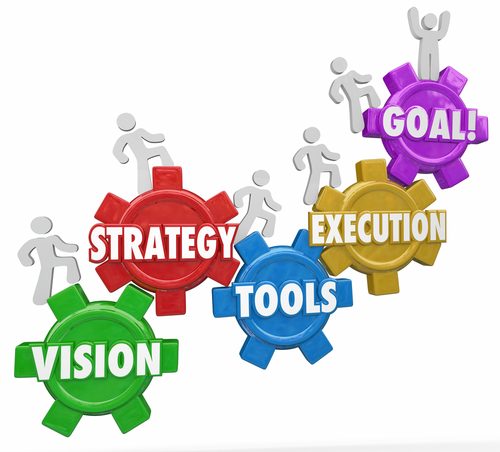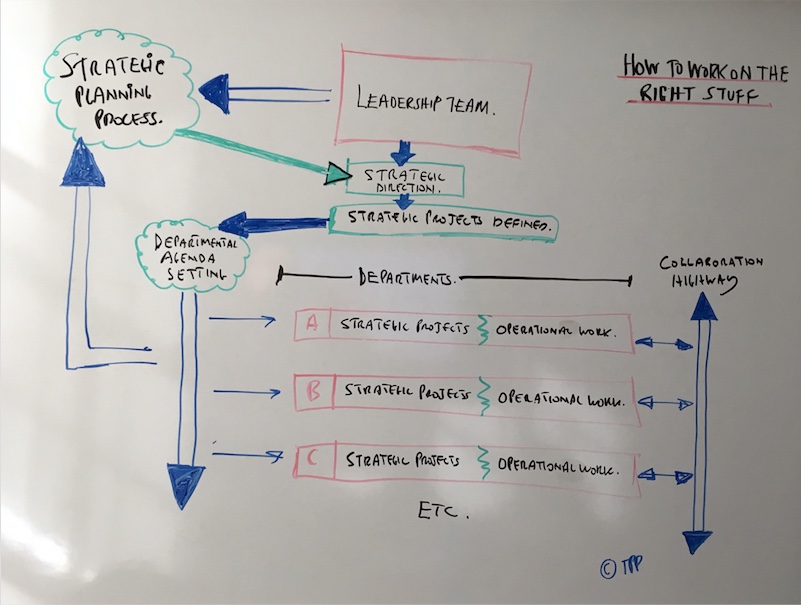Why do so some companies win and others fail? How is it possible for a new management team to transform the performance of a business? What is the essential difference between winners and losers? In a previous post a few years ago I emphasized the importance of execution – Why a Great Strategy Isn’t Enough. But I’d like to identify a specific technique that blends great strategic thinking with effective execution. I’m calling it “Strategic Execution”. We rarely see management not working hard enough but we often see management not working smart enough.
We all understand the dangers of silo thinking. People stuck in their own departmental problems disconnected with the real world. How can you change that? How can you create symbiotic relationships between departments?
The problem lies in thinking that departments have one function e.g. record the financial performance of the company, bring in sales (any sales), organize trade shows, build products, train people etc. The solution is surprisingly simple, but it requires a change in mindset from leaders. It requires the leadership team to embrace the concept of Strategic Execution.
Every department has two levels of functionality. There is the strategic function and there is the day to day stuff that keeps the trains running. Management often confuse these. Creating symbiotic relationships between departments can only happen with the strategic function at play. It will never happen if department heads are in “day to day” mode. Every department has a strategic role as well as a departmental functional role.
Visually think of departments operating at two levels. The top level forms a symbiotic relationship with other departments aligned with the strategic goals of the company. Take the example of launching a new product. Product management in their strategic function mindset (as opposed to their day-to-day mindset of editing a product brochure) have identified major new challenges in the marketplace. It could be because of the huge demand for bandwidth in the wireless space, or because of the change in materials technology affecting the aerospace sector or new opportunities created by the Internet of Things (IoT). The executive management team have set ambitious goals, the product management team have identified a viable gap in the product family but we need to engage the R&D team in assessing the product. Marketing and sales departments need to be involved in articulating the competitive value proposition that clarifies the needs of the market. Finance teams need to analyze the potential ROI on such an investment. And all of this requires to be done quickly, efficiently and with a common purpose to get to market before the opportunity is lost.
I’ve illustrated below the concept of splitting the departmental agenda between strategic priorities and operational ones.
The Strategic Planning Process drives the priorities.
This is how really successful companies separate themselves from 90% of their competitors. It’s not just about strategy. It’s not just about execution. It’s the interwoven, symbiotic play that delivers remarkable performance. Strategic Execution however demands many operational protocols to be in place. First it requires department heads to recognize they are not on islands!
It requires a more formal approach to strategic planning whatever your size of company. It requires playbooks in sales, marketing, and new product development that bring people together. It requires courage from the CEO to set the strategic agenda and demand that departmental strategic agendas are aligned to the big audacious goals. The culture of the company needs to embrace the power of strategic thinking. Projects that require multi-departmental input move the dial. It’s not that operating the payroll, or changing sales commission plans, or editing blog posts aren’t important, but they must be recognized for what they are – day-to-day stuff.
By recognizing the two fundamental different functions of every department you will ensure people are working on the right stuff.
Too often the essential day to day activities dominates the departmental agenda. The key symbiotic relationships between departments is at best weak or non-existent. The phrase used by Jim Collins in his great series of books comes to mind. Zooming out to see the bends in the road and zooming in to ensure that people are working together on the right stuff.
Strategic Execution creates alignment of effort. It develops a purpose across an organization, ensures that products and services are compelling and competitive and transforms the productivity of every team member.
Reach out at Ian@TPPBoston.com for more information on our tools for creating an organization built around these principles.









